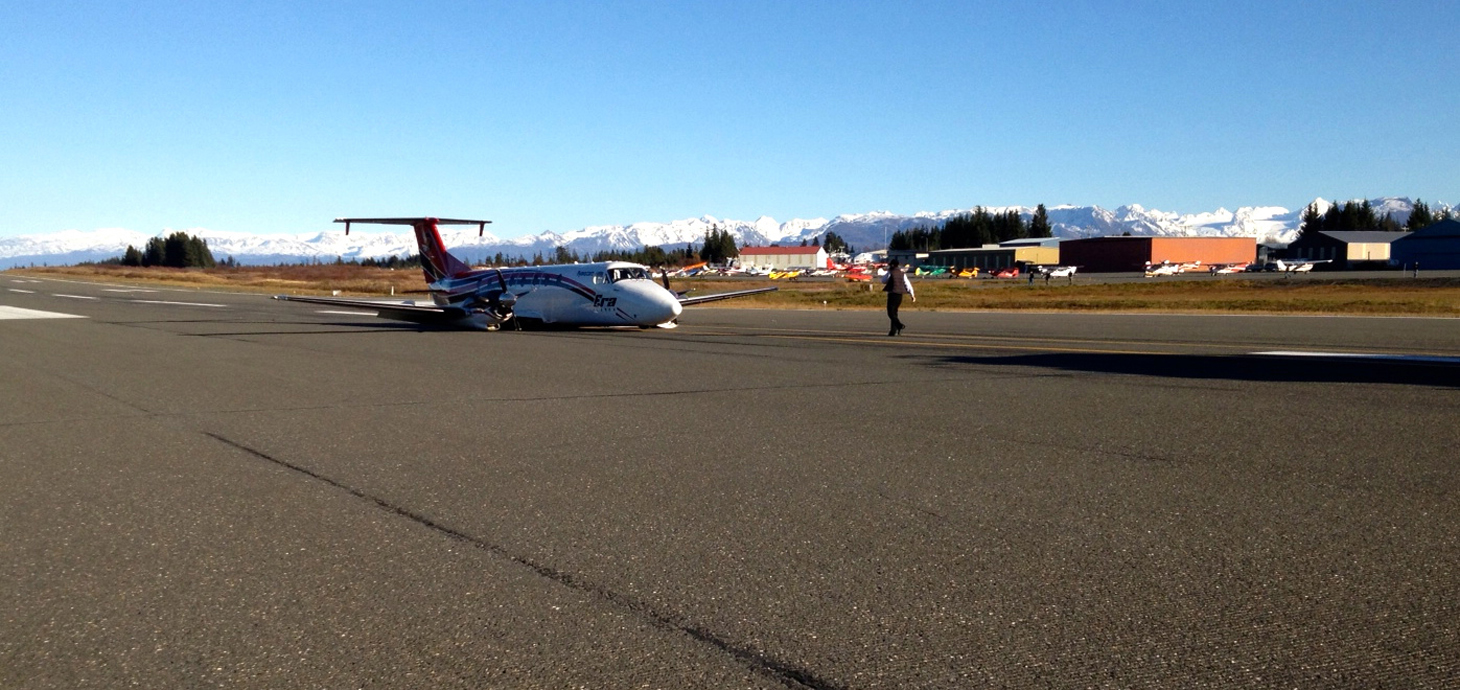The Federal Aviation Administration and National Transportation Safety Board are still investigating the cause of an Oct. 23 Era Alaska crash at the Homer Airport. All 13 passengers and two crew members on an Era flight from Anchorage to Homer walked to safety after the plane’s landing gear apparently collapsed as it was arriving about 3:30 p.m. Oct. 23.
The Beechcraft 1900C airplane skidded from the east end of the main runway to near the terminal building before stopping.
Homer Volunteer Fire Department firefighters and emergency medical technicians responded and evaluated the passengers and crew, but no one needed transportation to the hospital, Chief Bob Painter said in a press release.
A Homer Airport rescue firefighter with the airport rescue truck arrived on scene first and reported no leaking fuel or fire, Painter said.
“It was a landing roll which turned into a landing slide,” said National Transportation Safety Board investigator Clint Johnson of Anchorage.
Last Thursday, the Beechcraft had been raised on landing gear and parked by the Bald Mountain Air hangar. FAA officials and Era workers removed two recorders, a cockpit voice recorder and a flight data recorder. Those were sent to NTSB headquarters in Washington, D.C., for analysis.
The results of the analysis will determine the next phase of the investigation, including a mechanical inspection if needed, Johnson said.
Shelley Gill, a Homer writer on the plane, had been returning from a day trip to Anchorage where she participated in a protest against the state of Alaska and the Pebble Project trying to recover legal fees from former First Lady Bella Hammond and former state Sen. Vic Fischer, plaintiffs in an unsuccessful suit against the state.
Gill said the plane weaved back and forth on its belly across the runway “like a drunk driver.” She said the pilot was very calm during the landing.
“You just wait for that wing tip to drop down when you’re skidding 100 mph on your belly and you’re done,” Gill said. “It didn’t happen. I don’t know if it was something she (the pilot) did, but if it was something she did, she ought to get a medal.”
Chris Russ, a Homer passenger waiting to board the plane for the return flight to Anchorage, said no one noticed the crash until people in the terminal saw the plane sitting on its belly. He said he then saw passengers and crew walking into the terminal.
“The look on their faces — they looked like some people who felt pretty lucky,” Russ said.
When the Beechcraft first touched down at the eastern end of the runway, Gill said she felt the landing gear roll for a few seconds, and then one wheel collapsed and then the other.
“You felt the tires blow and then we were on our belly skidding very fast,” she said.
Gill sat one seat behind the exit door over the right side of the wing. She told a man sitting in front of her to be prepared to get ready to leave the plane. Everyone acted calm, Gill said. Some smoke from burning tires came into the cabin when the copilot opened the door. People got out of the plane smoothly and safely, she said. The pilot stood by the passengers outside the plane as they evacuated.
“I just want to say, ‘Is your hair gray under that hat?’” Gill said she asked the pilot. “She said, ‘Not today, but it might be tomorrow.’”
The Beechcraft had two carbon-composite props. Gill said as the plane slid on its belly, the tips of the props shredded away. On Thursday, the propellers were frayed at the edges and about half the original length. Gill said seeing the composite props tearing apart reassured her.
“There wasn’t just some big piece of steel prop hurtling through the sky and coming through the window and skewering me,” she said.
Amanda Combs, an account executive with Northwest Strategies, a public relations firm representing Era, said last week that because the accident was still under investigation, Era could not provide any more information beyond a basic press release about the crash.
The Era plane that crashed is the same model as a Ryan Air Beechcraft 1900C that crashed Nov. 23, 1987, at the Homer Airport on a flight from Kodiak. That crash killed 18 people, including two flight crew members and 16 passengers. The NTSB determined the Ryan Air Beechcraft had not been properly loaded and crashed when its center of gravity shifted and airplane control was lost.
Michael Armstrong can be reached at michael.
armstrong@homernews.com.


